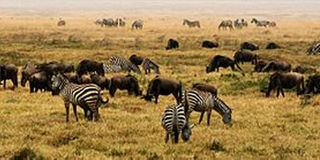Tanzania faces decline in wildlife population: report

What you need to know:
The 2016 Tanzania Human Rights Report by the Legal and Human Rights Centre (LHRC) points out some other causes as climate change, poverty, poaching and illegal logging, which it says are a threat to the survival of wildlife in sanctuaries.
Dar es Salaam. Tanzania faces a decline in wildlife population and environmental degradation due to population growth, environmental mismanagement and economic activities, a report indicates.
The 2016 Tanzania Human Rights Report by the Legal and Human Rights Centre (LHRC) points out some other causes as climate change, poverty, poaching and illegal logging, which it says are a threat to the survival of wildlife in sanctuaries.
“There is a need to develop sustainable management of natural resources, which will involve local communities living around and near areas of conservations,” reads part of the report.
It says at local level, the district authorities around conservation areas should be improved in planning, coordination and management of natural resources through strengthening community-based natural resources management and benefit sharing schemes.
It also advises the government to improve socio-economic benefits to villages through infrastructural development, including the construction of feeder roads. “The infrastructure of protected areas should also be improved,” it says.
“At national level, the LHRC commends the work done by the Tanzania Wildlife Authority (TWA) in addressing challenges facing wildlife resources conservation, management and administration.
However, TWA should collaborate with local authorities in reservation areas to make local communities feel they are part of resources conserved, managed and administered,” the report says.
Tanzania has abundant rich natural resources, ranging from wildlife, minerals and forestry and emphasis has been laid on conserving its natural resources with 28 per cent of its land subjected to conservation protection.
The LHRC report shows that the majority of Tanzanians depend on the natural resources for their livelihood, but due to the country’s conservation and protection policy, ordinary people do not benefit much from it.
It further says natural resources provide an important source of revenue for the country.



